|
|
Leonardo da Vinci: Anatomical Drawings from the Royal Library, Windsor Castle. — New York, 1983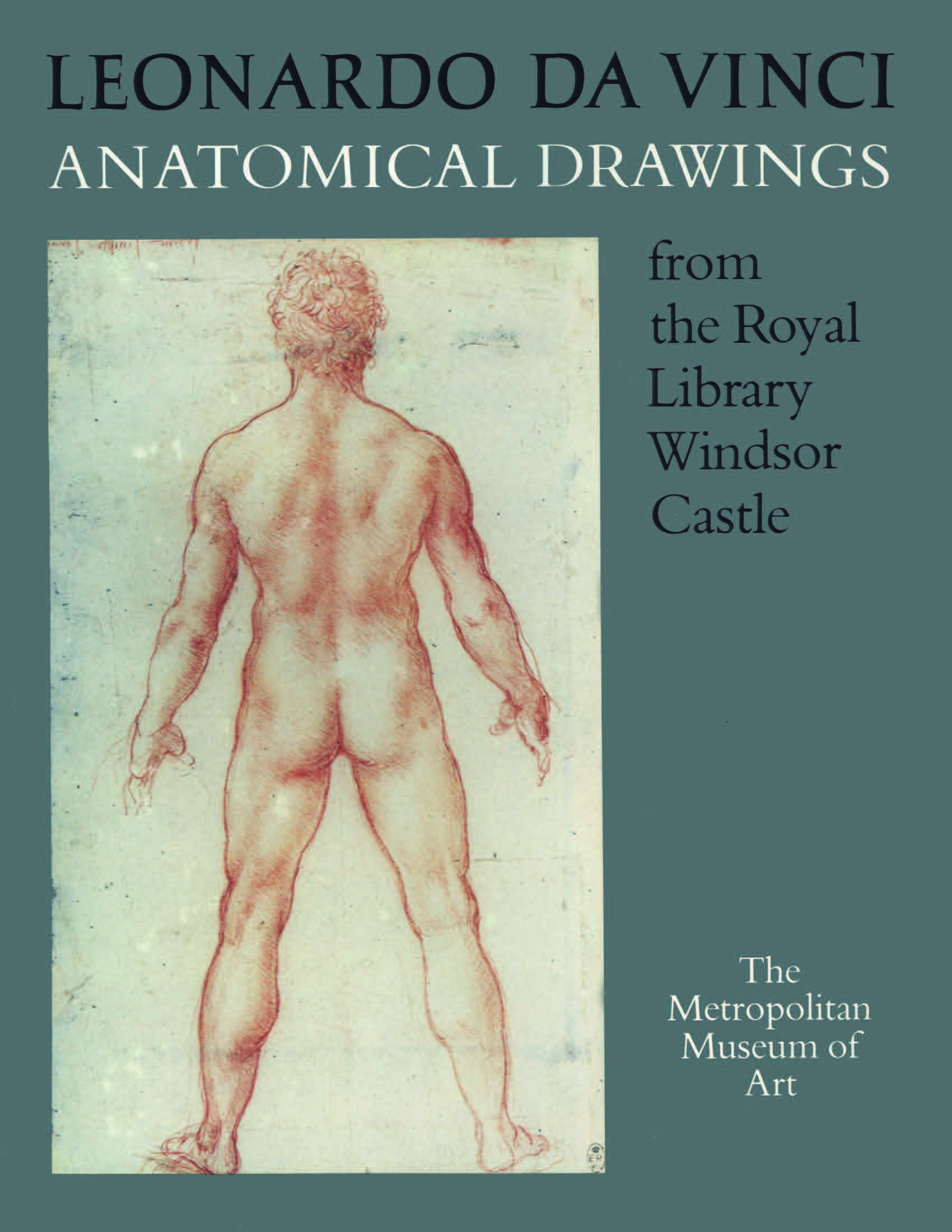 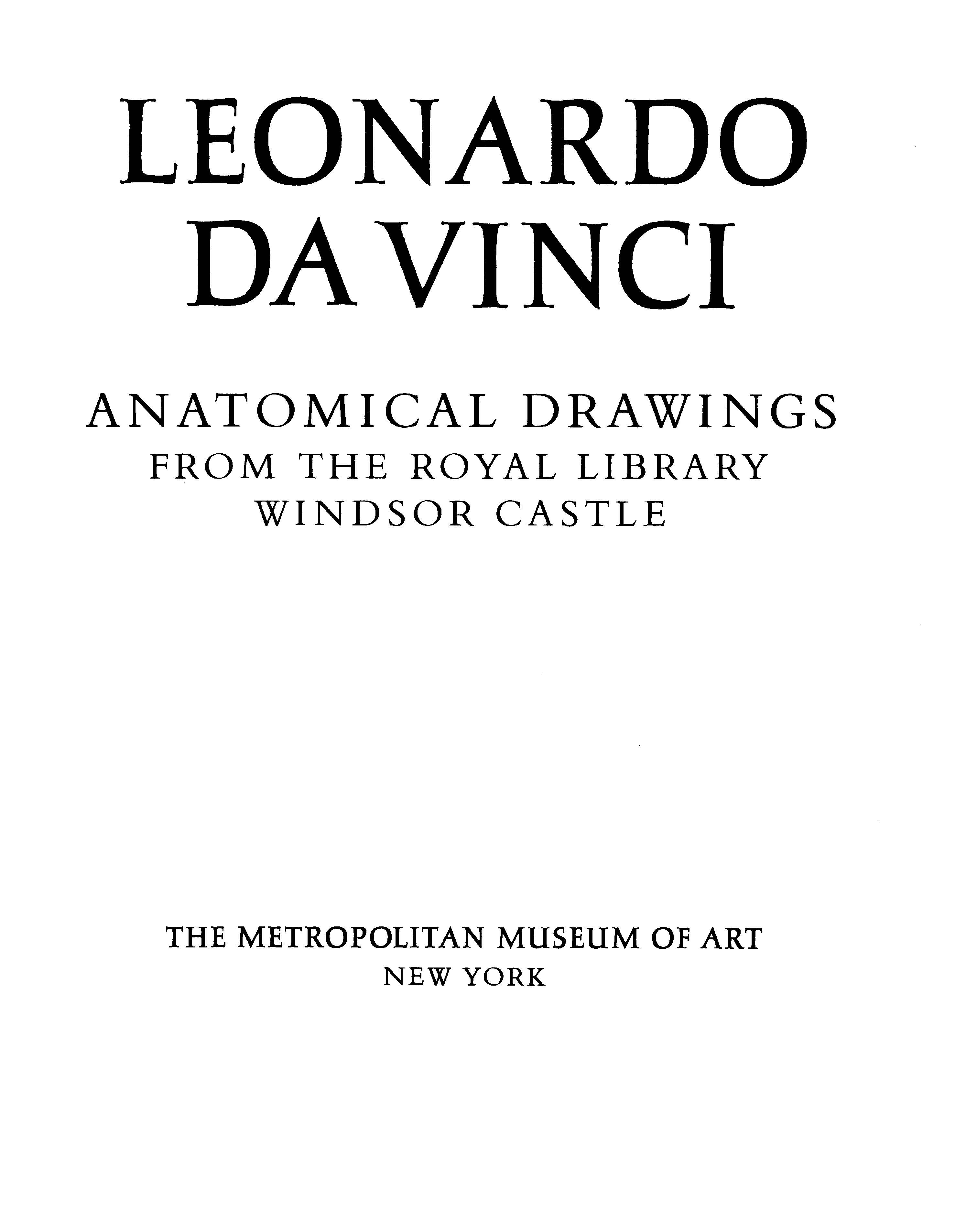 Leonardo da Vinci: Anatomical Drawings from the Royal Library, Windsor Castle / Catalogue entries are by Kenneth D. Keele and Jane Roberts. — New York : The Metropolitan Museum of Art, 1983. — 167 p., ill. — ISBN 0-87099-362-3
These fifty sheets of drawings of the human body by Leonardo, made between about 1485 and 1510–15, are based on the artist's own anatomical dissections and show his evolving understanding of physiology. The drawings demonstrate, as well, Leonardo's progress from technical mastery of his subject to consummate draftsmanship. As Sir Robin Mackworth-Young, librarian of Windsor Castle, says of Leonardo in his Preface: "In the primitive conditions of the late fifteenth century, and with no medical training, this astonishing man acquired a knowledge of human anatomy far in advance of the medical profession of his day. And the studies in which he recorded his findings bear comparison as works of art with his exquisite portrayals of the exterior of the human form and of horses, or with his dramatic representations of mountainous landscapes."
The catalogue documents the second exhibition of Leonardo's drawings from Windsor; Leonardo da Vinci: Nature Studies was shown at the Museum in 1981. The present catalogue contains a chronological table, glossary, table of concordance, and bibliographical note. Catalogue entries are by Kenneth Keele and Jane Roberts.
FOREWORD
The use of superlatives to describe Leonardo da Vinci, the most sensitive and relentlessly curious of men, is entirely justified. Moreover, his consummate draftsmanship and sovereign intelligence are often best preserved and seen in his works on paper. The Royal Library at Windsor Castle, with its collection of six hundred drawings by Leonardo, constitutes the richest enclave of this master’s works on paper.
In the spring of 1981, the Metropolitan Museum, in collaboration with the J. Paul Getty Museum in Malibu, California, mounted an exhibition of fifty of Leonardo’s nature studies, an unprecedented and indeed generous loan from the Royal Library at Windsor. Quod erat expectandum, the exhibition was an enormous success. We now delight in offering our visitors another exhibition of Leonardo’s drawings, a superior selection of fifty anatomical studies, works that are widely acknowledged as among the finest of Leonardo’s creations on paper. Remarkable for their scientific exactness, these works are moving testimony not only to the artist’s probing and fecund genius, but also to the most ennobling of life’s miracles—the human anatomy.
We are most grateful to Her Majesty the Queen, who graciously agreed to lend this particular core of Leonardo’s work. For the selection of the drawings, we should like to thank Sir Robin Mackworth-Young, Royal Librarian, Windsor Castle, and the Hon. Mrs. Roberts, Curator of the Print Room, Royal Library.
With respect to the installation of the exhibition in New York, I should like to acknowledge the respective roles of James Pilgrim, Deputy Director of the Metropolitan, Jacob Bean, Curator of Drawings, Helen Mules, Assistant Curator of Drawings, and John Buchanan, Registrar, for overseeing the myriad aspects entailed in mounting the exhibition. We are also grateful to Paul Williams, London, who was assisted by Hamish Muir, London, for their skillful installation design.
Philippe de Montebello
Director, The Metropolitan Museum of Art
PREFACE
Of all the men of genius who played a part in the Italian Renaissance, none is more remarkable than Leonardo da Vinci. Master of any discipline to which he set his hand—painting, sculpture, architecture, anatomical dissection, engineering, music—he exemplified the spirit of inquiry about nature to which the vast corpus of modern scientific knowledge owes its origin.
The impact of his genius has been preserved for us more directly than that of most of his contemporaries by his extraordinary talent for drawing. This he used for recording his thoughts, experiences, and discoveries much as a diarist or a scholar uses words, thus preserving for a later age intimate access to the very workings of his mind. An idea is set down as it emerges, perhaps filling a vacant space on an already crowded sheet. A few strokes of chalk, pen, or stylus suffice not only to record some outer object—or some product of the imagination—but also to invest it with an inner energy, often of striking intensity. Sometimes he is processing a detail for a larger composition, sometimes simply recording knowledge. Words are not excluded, but are usually supplementary, appearing as comment by the side of some sketch. One such comment on an anatomical drawing explains his method. The use of drawing gives “knowledge that is impossible for ancient or modern writers [to convey] without an infinitely tedious example and confused prolixity of writing and time.”
Nowhere is this method better exemplified than in the anatomical series of drawings, whose interest is as much scientific as artistic. In the primitive conditions of the late fifteenth century, and with no medical training, this astonishing man acquired a knowledge of human anatomy far in advance of the medical profession of his day. And the studies in which he recorded his findings bear comparison as works of art with his exquisite portrayals of the exterior of the human form and of horses, or with his dramatic representations of mountainous landscapes.
On Leonardo’s death the contents of his studio, which included several thousand drawings, passed to his favorite pupil, Francesco Melzi, whose handwriting may be seen on 19B in the present exhibition. On Melzi s death (about 1570) most of the collection was bought by the sculptor Pompeo Leoni, who rearranged the folios and bound them into volumes. Leoni, who was court sculptor to the king of Spain, took some of the volumes to Madrid. After his death in 1609, one volume, containing examples of every field in which Leonardo worked, was acquired by the celebrated English collector Thomas Howard, Earl of Arundel, who brought it to England. While it belonged to him some of its drawings were engraved by Wenceslaus Hollar. Arundel had to leave the country during the Civil War, and it is uncertain whether or not he took the volume with him. According to Count Galeazzo Arconati, who gave other Leonardo manuscripts to the Ambrosian Library in Milan, drawings concerning anatomy, nature, and color were “in the hands of the King of England” before 1640. This statement, and the fact that virtually all the surviving anatomical drawings by Leonardo are now in the Royal Collection, having formed part of the volume bought by Arundel, suggests that the volume did not leave the country, but was acquired by King Charles I. Others have surmised that it may not have reached the Royal Collection until after the restoration of King Charles II, to whom it could well have been sold or presented by Sir Peter Lely, one of the keenest collectors of drawings of his day. By whatever route it reached the Royal Collection, it is recorded as being in the possession of Queen Mary II in 1690, a year after she and her husband ascended the English throne as joint monarchs.
This volume contained all the six hundred folios now at Windsor. During the three centuries that they remained within its covers, those executed in chalk suffered considerably from rubbing. To prevent further damage, most of the single-sided drawings were laid down on separate mounts in the nineteenth and early twentieth centuries. This technique could not however be applied to the anatomical series, most of whose folios bear drawings on both sides of the paper. The only solution was to rehouse them in new bindings, which exposed them to the same dangers as before. In recent years a new technique, which eliminates these dangers, has been devised. Each folio is encased within two thin panes of transparent plastic sheeting, and the resultant sandwich is inserted into a thick cardboard mount furnished with openings on both sides. Thus sheathed, a folio bearing a drawing on either side can not only be safely handled, but can also be placed on exhibition.
Before being mounted in this way the folios were examined and photographed under ultraviolet light, sometimes with remarkable results (see 3, 4, 5A and B, 6A and B, 7).
A small selection of these drawings was exhibited in Washington and Los Angeles in 1976. The present much larger exhibition, which comprises about a quarter of the anatomical series, was shown in London in 1977 and later in Florence, Hamburg, Mexico City, Adelaide, and Melbourne. The entries for the catalogue were prepared by Kenneth Keele and Jane Roberts.
The entire series of anatomical drawings has been published in facsimile by Harcourt Brace Jovanovich, with a definitive catalogue by Kenneth Keele and Carlo Pedretti that includes a full transcription and translation into several modern languages of all the manuscript notes on the drawings.
Robin Mackworth-Young
Librarian, Windsor Castle
INTRODUCTION
These anatomical drawings by Leonardo da Vinci from the Queen’s collection at Windsor Castle have been selected and displayed as a synthesis of Leonardo’s contributions to art and science in a field of endeavor that occupied him for a period of nearly thirty years, from about 1485 to 1510–15. The material is subdivided into nine groups according to a convenient subject-matter classification. This arrangement contributes to an even distribution of highlights in the visual impact produced by the beauty and precision of the drawings, but upon closer scrutiny it will soon become apparent that this material is best appreciated from the viewpoint of chronology, which gives the element of time perspective in the unfolding of Leonardo’s thought. It is indeed this arrangement, or approach, that characterizes the facsimile edition of the total collection of Leonardo’s anatomical studies at Windsor. It is quite appropriate, then, that this exhibition should open with an introductory section of two drawings only—one early and one late—showing an extraordinary progress in anatomical knowledge as Leonardo moves from traditional sources of learning, namely Mondino, to combine them with knowledge acquired through dissection, thus giving vividness and intensity to his vision of the human body as a machine.
Much of what has become famous of Leonardo’s involvement with technology—his extraordinary way of presenting the operating power of a machine—comes to be projected into these images of the human body, in which one may even detect the same pulsating effect that Vasari said was to be perceived in the throat of Mona Lisa.
Leonardo’s training as an artist in the Florentine studios of the late quattrocento coincides with an emerging concern for the representation of the human figure in action. With the Pollaiuolos it was not only the matter of assembling a vocabulary of gestures and attitudes, but also of introducing a new sense of vitality in the line of their drawings, the quick and lively notation of movement replacing the slow, careful definition of form: a quality of line that appeals to Leonardo as early as 1473, when he first discovers how light affects the vision of rocks, and trees, and waters, and fields, as he draws a landscape of the Arno valley that is a prefiguration of his later approach to natural forms in terms of structure and of a continuous flow of energy.
Leonardo’s first codification of this new approach to natural forms and to the human figure comes with his Vatican St. Jerome, the unfinished painting that dates from the time of the Adoration of the Magi, about 1480. This is often mentioned as evidence of an anatomical knowledge based on dissection. It is indeed amazing how the muscles of the neck and shoulders should be so brilliantly displayed as to bear comparison with the most skillful analysis of the same muscles thirty years later, in the drawings of about 1510 shown in this exhibition (e.g., 27A and B). But the St. Jerome is above all the first document of Leonardo’s principle of representing the human figure “in context,” as if architecturally conceived in ground plan and elevation so as to enhance its volumetric presence in relation to its setting. This explains the extraordinary vitality of all the paintings he was to produce later, when, for instance, the grotto of the Virgin of the Rocks was to be made so intimately related to the character of the figures it envelops as to be immediately felt as an integral part of the iconographie program and not to be taken simply as a decorative backdrop. Whenever, in fact, the human figure is presented as the nucleus of a natural setting, the equation between the figure and the generative forces of nature is implied. Hence the parallel that can be drawn between the celebrated drawing of a child in the womb and a human figure surrounded by an enveloping landscape, as in the Mona Lisa, in Leda, and in the Virgin and Child with St. Anne. And since generation is also transformation, the link is soon established with the stereometric principles in the architecture of the High Renaissance, when Bramante would conceive of a building as the nucleus of an enveloping architectural setting.
Leonardo and Bramante were friends. Little is known of the interaction of their ideas, the outcome of which, however, is that period of grandeur and monumentality in Italian art that is rightly viewed as a revival of the ideals of antiquity. It is an expression of intellectual clarity and power that reflects the imperial ambitions of popes and monarchs and the civic pride that was the basis of the socially reorganized Florentine Republic. The splendor and majesty of forms, both human and architectural, postulated by the artistic principles of Leonardo and Bramante were to lead inevitably to the academic art inherent in Raphaels response to those principles. And with this came the anxiety of an age of reforms that Michelangelo was best to express with his concept of the human body in attitudes of struggle.
Carlo Pedretti
LEONARDO DA VINCI THE ANATOMIST
To say that Leonardo da Vinci was a unique genetic mutation is perhaps only to put into modem language Vasari's sixteenth-century verdict that “his genius was the gift of God.” But this gift or mutation was expressed not only in his intellect, but in his physique also. Moreover, Leonardo’s approach to the anatomy of the human body was significantly influenced by his own remarkable physical attributes. According to Vasari, he combined in himself exquisite sensory sensitivity with great physical strength and dexterity, if we may use this term for a man whose writing and drawings throughout his life were left handed. And it happens that his work in anatomy falls into two clear-cut periods of his life that correspond to those sensory and motor attributes of his nature.
Leonardo's remarkable genetic endowments were derived from a peasant girl, Caterina, and a Florentine notary, Ser Piero da Vinci. Their bastard son, Leonardo, was born at Vinci on 15 April 1452. From a very early age he is said to have shown exceptional ability in geometry, music, and artistic expression. Ser Piero, noticing this, took his sons drawings to his friend Andrea del Verrocchio in Florence. Verrocchio was so struck by their quality that he accepted the promising young man straight away into his workshop. Verrocchio himself was well aware of the importance of perspective in art as well as the potential enrichment to art of representing the human body by a knowledge of anatomy. Like Leonardo he was an unlettered man, unimpeded by traditional learning from personal observation and the practical application of his ideas.
In a neighboring bottega the brothers Antonio and Piero del Pollaiuolo were similarly anatomically minded, using their knowledge as a basis for such pictures as the Martyrdom of St. Sebastian (London, National Gallery). Such a background provided Leonardo with an ideal point of departure for his own painting of St. Jerome (Rome, Vatican Museum), in which the anatomy of the head and neck so dramatically portrays the agony of his soul.
Perspective, however, was a less congenial subject to Verrocchio, who was daunted by its geometrical requirements. Not so Leonardo, who forged ahead in this field, basing his studies on the work of Leon Battista Alberti and Piero della Francesca. From experimental observations of objects through a vertical glass pane, or pariete, Leonardo came to appreciate the relation between perspective and the quantitative or measured observation of external bodies in their true proportions. This realization led him to apply himself to the objective representation of machines with such a degree of measurable accuracy that they have been reconstructed in recent years. It soon occurred to Leonardo that the same perspectival principle could be applied to extract “true knowledge” from the “universal machine of the earth.” And what applied to the macrocosm of the earth applied also to that microcosm, the living body of man, which like the great “terrestrial machine” is “enclosed in the sphere of air.”
Thus Leonardo's early explorations into human anatomy focused on the nature of “experience,” and in particular of perspectival experience. It is mainly in these early years, about 1490, that we find his many diatribes against the “authorities.” For instance: “Many will think that they can with reason blame me, alleging that my proofs are contrary to the authority of certain men held in great reverence by their unexperienced judgments, not considering that my works are the issue of simple and plain experience which is the true mistress” (Codex Atlanticus, f. 119va). This was written in those very same years during which he was carrying out diligent and painstaking experiments on perspective as well as his first anatomical dissections.
In this first period of Leonardo’s anatomical studies, from about 1487 to 1493, it is interesting to observe how dissections of the sensory nervous system, particularly those parts concerned with vision, predominate. This assertion is only apparently contradicted by the fact that the finest drawings of the skull that he ever made were drawn at this time. One notices, however, that the text alongside these early drawings of the skull (as, for example, 8A) is largely devoted to the location of the center of the senses and vision within the skull. Here the system of crossing lines is mainly devoted to demonstrating the site of “the confluence of all the senses,” that is, the senso commune, in which he locates the soul. And in the lower drawing on the same page the optic nerves find clear and isolated representation. Again, on the verso of this folio (8B), alongside his marvelous exposure of the orbit and maxillary sinus, he writes: “The eye, the instrument of vision, is hidden in the cavity above... The hole b [the optic foramen] is where the visual power passes to the senso commune.” It was thus that he gave anatomical reality to his description of the eye as “the window of the soul.”
This preoccupation with the physiology of vision even in such an unlikely anatomical context betrays the fact that the majority of Leonardo’s many studies of the eye and vision are not to be found in his so-called anatomical manuscripts, but are scattered about elsewhere. All of them, however, are aimed at a deeper understanding of the nature of the subjective side of “experience” as obtained from all the senses, not only the eye. In parallel with this he was attempting to analyze the nature of the objective observation of natural phenomena, such as the shape, size, and distance of objects, using the technique of perspectival proportions on the vertical glass pane. Through the combination of perspective and physiology of vision Leonardo hoped to understand how “the mind of the painter must of necessity be transformed into nature’s mind in order to act as an interpreter between nature and art” (Treatise on Painting, f.24v). Thus did Leonardo bridge the chasm between science and art.
After he felt that he had achieved an understanding of how “experience” could act as an interpreter between nature and art, Leonardo abandoned his anatomical investigations for nearly twenty years. During these years he was developing his science of the macrocosm of the world, which he called the “terrestrial machine.” Finding simple linear perspective inadequate for solving distance problems, he extrapolated the principle of perspective to color and aerial perspective. He also formed the view that similar perspectival rules could be further extended in nature to the realm of what he called “the four powers of nature”: movement, weight, force, and percussion, acting on the four elements of earth, air, fire, and water. All power, because it did not occupy space, he saw as “spiritual” forms of energy, manifested in movement or change. Having performed innumerable experiments with pulleys, levers, mirrors, lenses, and particularly with water, he came to the conclusion that these powers obeyed a perspectival or “pyramidal” form of action (“All the powers of nature have to be called pyramidal.” Codex Atlanticus, f. 151r-a).
At first Leonardo applied his rules of mechanics to the movements of man’s body as a whole—to his center of gravity, to the actions of walking, running, and swimming. Many such studies are to be found in his Treatise on Painting.
About 1495 Leonardo became friendly with the mathematician Luca Pacioli, who propounded to him the works of such classical masters of mathematics as Euclid and Archimedes. This turned Leonardo’s interest even more strongly toward the conviction that geometry held the key to the interpretation of nature; and this included the effects of the “four powers” within the body of man and of animals.
The opportunity to pursue anatomy further seems to have occurred by chance during one of Leonardo's visits to the hospital of Santa Maria Nuova in Florence. He tells how
an old man a few hours before his death told me that he had passed a hundred years, and that he did not feel any bodily deficiency other than weakness. And thus while sitting on a bed in the hospital of Santa Maria Nuova in Florence, without any movement or sign of distress he passed away from this life. And I made an anatomy of him in order to see the cause of so sweet a death... This anatomy I described very diligently and with great ease because of the absence of fat and humors which much impede knowledge of the parts (R.L. 19027V).
In the performance of anatomical dissection Leonardo experienced the satisfaction of putting both his artistic and scientific principles into practice. Consumed as he was by curiosity and a passion for investigation, he was never one who believed in science for science’s sake. At the end of one of his paeans in praise of science he concludes abruptly with the verdict: “From it [science] is born creative action, which is of much more value.” And among his anatomical notes he comments: “This generation deserves unmeasured praises for the usefulness of the things they have invented for the use of man: and would deserve them even more if they had not invented noxious things like poisons and other similar things that destroy life or the mind” (R.L. 19045V).
Thus when Leonardo returned to anatomical investigation he put into practice all the scientific knowledge acquired since his earlier studies some twenty years before. This time the focus of his attention was centered on the movements in man’s body. He sums up his outlook well on R.L. 19060R, alongside a drawing of the maternal and fetal circulations:
Why nature cannot give movement to animals without mechanical instruments is demonstrated by me in this book on the actions of movement made by nature in animals. For this reason I have composed the rules of the four powers of nature, without which nothing through her can give local motion to these animals; and how this movement engenders, and is engendered by, each of the other three powers... We shall begin by stating that every insentient local movement is generated by a sentient mover, just as in a clock the counterpoise is raised up by man, who is its mover.
Again, right in the middle of some beautiful drawings of the anatomy of the hand, on 32B, Leonardo suddenly breaks out with the injunction: “Make the book on the elements and practice of mechanics precede the demonstration of the movement and force of man and other animals, by means of which you will be able to prove all your propositions.”
Leonardo’s anatomical drawings can be looked at and enjoyed by many different kinds of eye. For example, the eye of the artist will see in them the skill of his perspectival reduction of a three-dimensional object into a two-dimensional representation and the delicate hatchings of light and shade giving birth to the illusion of relief. The scientific eye will appreciate the three-dimensional accuracy of what he portrays: his insistence on the demonstration of all parts from at least three aspects, from in front, behind, and the side. To this he added his uncanny power of illustrating the mechanics of the movement of joints and muscles.
Leonardo himself gave most diligent attention to developing his technique of anatomical illustration. One of many such passages (abbreviated) runs:
This plan of mine of the human body will be unfolded to you just as though you had the natural man before you. The reason is that if you wish to know thoroughly the parts of man after he has been dissected you must either turn him, or your eye, so that you examine him from different aspects, from below, above, and from the sides... But you must understand that such knowledge as this will not continually satisfy you on account of the very great confusion that must arise from the mixture of membranes with veins, arteries, nerves, tendons, muscles, bones, and the blood that itself tingesevery part with the same color... Therefore it becomes necessary to have several dissections: you will need three in order to have a complete knowledge of the veins and arteries: three others for a knowledge of the membranes: three for the nerves, muscles, and ligaments; three for the bones and cartilages, and three for anatomy of the bones, for these have to be sawn through in order to show which are hollow and which not... Three also must be devoted to the female body, and in this there is great mystery by reason of the womb and its fetus... (R.L. 19061r).
There is good reason to believe that Leonardo in fact carried out a great part, if not all, of this plan, for late in life he mentioned that he had dissected more than thirty bodies, and it is known that a number of small notebooks (libretti) offered to and refused by the grand duke Cosimo II de Medici in Florence in 1613 have since been lost.
For particular anatomical problems Leonardo devised ingenious solutions. For example, in order to clarify the action of joints as fulcra for movements of the bones, he separated their surfaces. “Thus you will give true knowledge of their shapes, knowledge that is impossible for either ancient or modem writers without an infinitely tedious example and confused prolixity of writing and time” (20A). When confronted with the problem of demonstrating the relations of muscles on different planes he advocates: “Before you form the muscles make in their place threads that should demonstrate the positions of these muscles; the ends of these [threads] should terminate at the center of the attachments of the muscles to the bones” (27B and R.L. 19017R). Thus he reduced bones and joints to levers acting on fulcra, and muscles to lines of force acting on these levers. When wishing to reveal the true shape of the ventricles of the brain, Leonardo utilized his skill in sculpture, making wax casts of them by injection, and then removing the surrounding brain tissue (10). When wishing to observe the movements of blood as it streamed out through the aortic valve of the heart, he made a glass cast of the part (38).
In summary, Leonardos anatomical drawings were of three main types: those derived from his medieval predecessors, drawings of “descriptive anatomy” from untrammeled observation, and drawings illustrating his own physical laws applied to the human body.
Anatomy in medieval times was very crude. Primitive squatting figures containing almost unrecognizable organs meant to be read symbolically, not as true representations, were standard works used by doctors. Some of Leonardos early anatomical drawings of about 1489 were founded on this medieval anatomy. For example, the drawing of the three cerebral ventricles (9A) represents them according to the pattern found in The Philosophy of Albertus Magnus, a copy of which Leonardo possessed. From another medieval work, Ketham’s Fasciculus of Medicine, Leonardo borrowed the outline of the human figure into which he inserted his own visualization of the “tree of the vessels” based upon the concept of Galen (1). In this same period he was making purely descriptive anatomical illustrations based on his own observations and made possible by his mastery of perspective. Such were those of the skull on R.L. 19058V, where for the first time the maxillary sinus in the cheekbone is demonstrated. This kind of illustration, based on direct dissection, was quite unprecedented.
By the eventual application of his physical laws to human anatomy, Leonardo achieved a wholly unique penetration into the mechanical principles of physiology. His contemporaries were quite unready for this. Indeed, descriptive anatomy itself did not come to the surface until Galenic anatomy was undermined by the successful revolutionary efforts of Vesalius in his magnificently produced work, De Humani Corporis Fabrica, published in 1543, twenty-four years after Leonardos death. This was the work for which contemporary anatomists were ready; this was the work that historically opened the floodgates of future anatomical progress. Thus in anatomy, as in so many other aspects of his life’s work, Leonardo was a man who awoke too early in the dawn of the scientific Renaissance while others still slept.
Leonardo unconsciously described himself and his own particular genius for anatomy in the following passage (R.L. 19070V):
You who say that it is better to look at an anatomical demonstration than to see these drawings would be right, if it were possible to observe all the details shown in these drawings in a single figure, in which with all your ability you will not see, nor acquire knowledge of more than a few vessels... And as one single body did not suffice for sufficiently long a time it was necessary to proceed by stages with as many bodies as would render my knowledge complete: and this I repeated twice in order to discover the differences.
But though possessed of an interest in the subject you may perhaps be deterred by natural repugnance, or if this does not restrain you then perhaps by the fear of passing the night hours in the company of these corpses, quartered and flayed, and horrible to behold. And if this does not deter you, then perhaps you may lack the skill in drawing essential for such representation, and even if you possess this skill it may not be combined with a knowledge of perspective, while if it is so combined you may not be versed in the methods of geometrical demonstration, or the methods of estimating the forces and power of the muscles; or you may perhaps be found wanting in patience so that you will not be diligent.
Concerning which things, whether or no they have all been found in me, the hundred and twenty books which I have composed will give their verdict, yes or no. In these I have not been hindered either by avarice or negligence, but only by want of time. Farewell.
Kenneth D. Keele
CONTENTS
Foreword. Philippe de Montebello.. 5
Preface. Robin Mackworth-Young.. 6
Introduction. Carlo Pedretti.. 8
Leonardo da Vinci the Anatomist. Kenneth D. Keele.. 10
Color Plates.. 15
Catalogue of Drawings.. 25
The Internal Organs (1–2).. 27
Early Anatomical Studies (3–7).. 31
Head and Brain (8–11).. 47
The Alimentary and Reproductory Systems (12–19).. 57
Muscles and Skeleton (20–33).. 81
The Heart (34–38).. 123
Comparative Anatomy (39–42).. 135
Human Proportions (43–46).. 143
The Nude (47–50).. 151
Chronological Table.. 163
Glossary.. 164
Table of Concordance.. 165
Bibliographical Note.. 167
Sample pages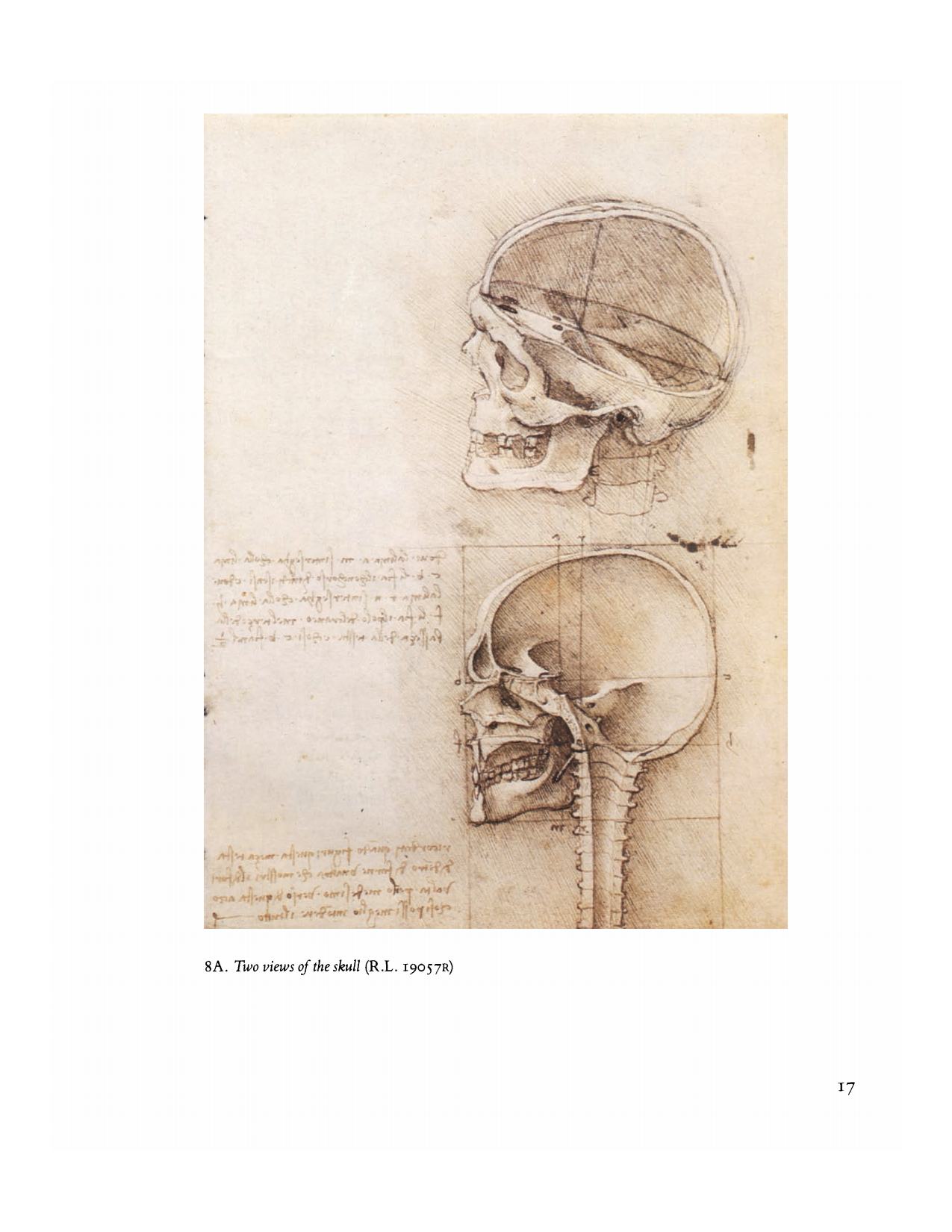 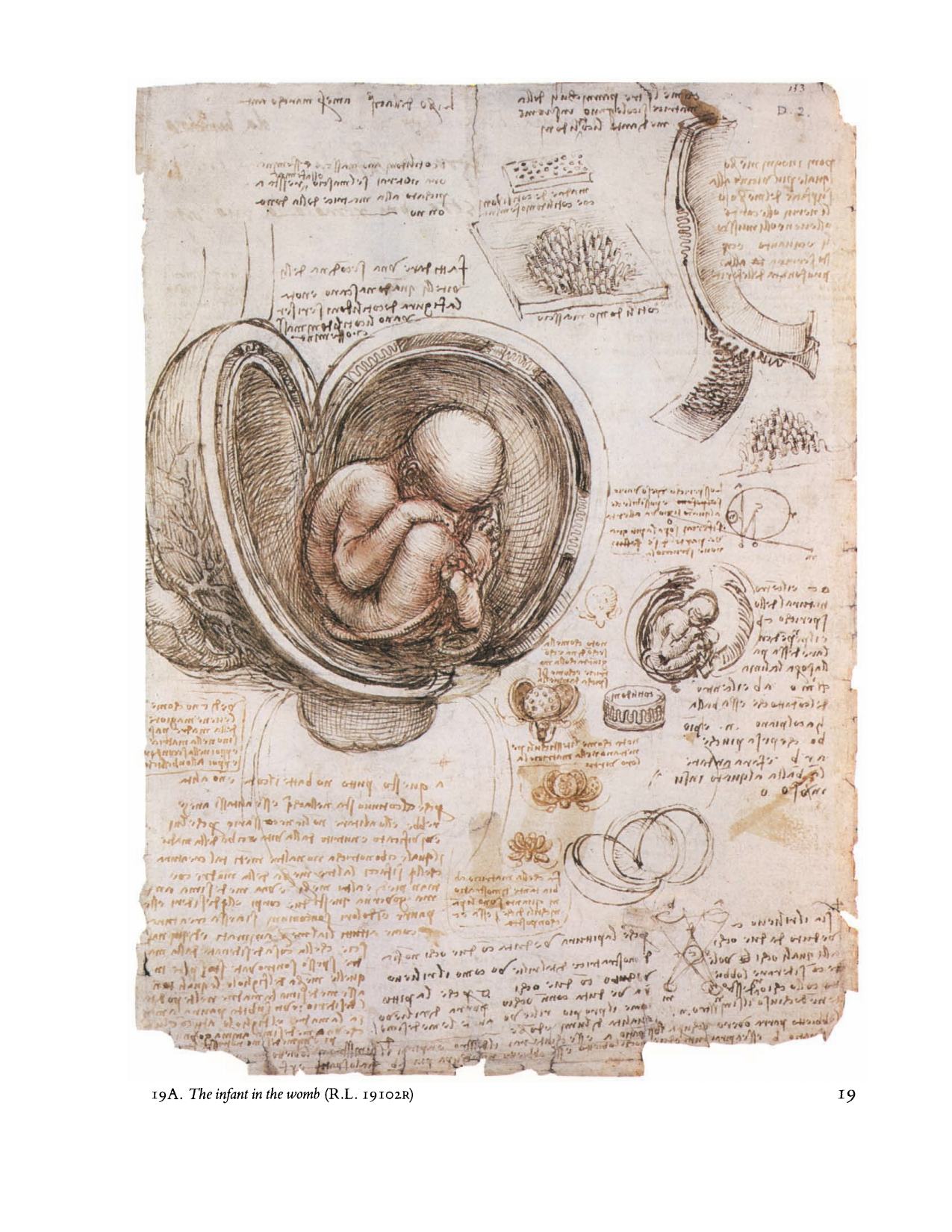 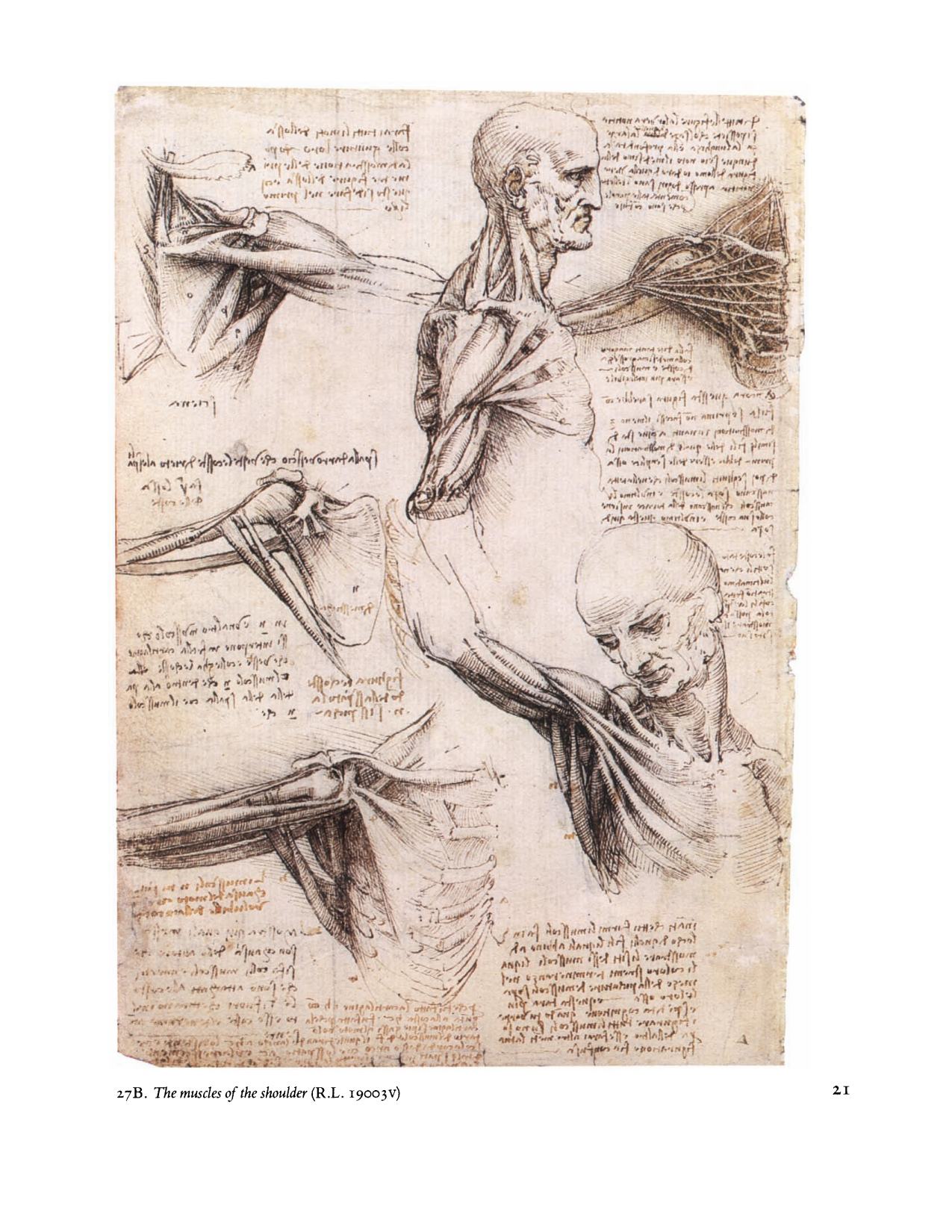 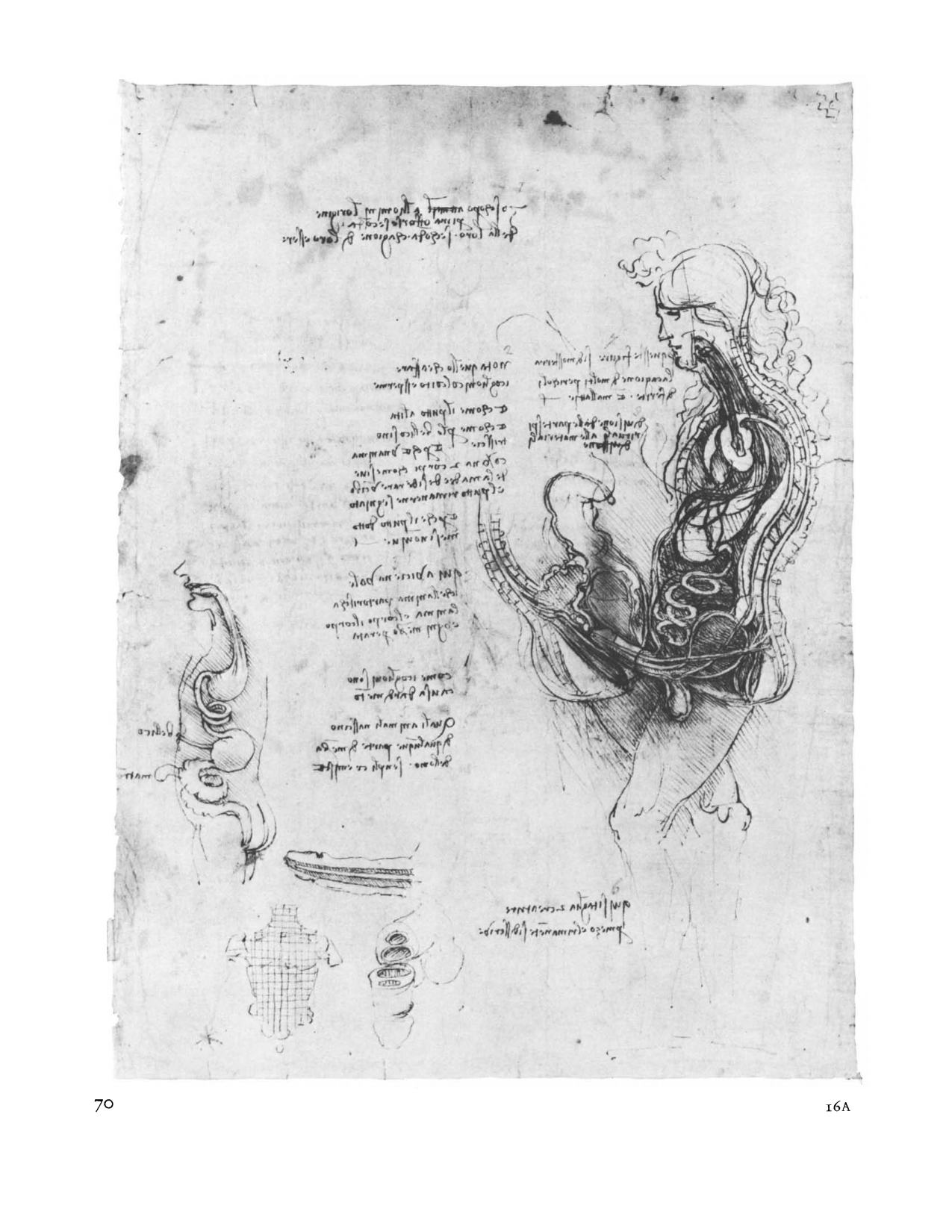
Download link (pdf, yandexdisk; 19,0 MB)
28 февраля 2020, 19:47
0 комментариев
|
Партнёры
|






Комментарии
Добавить комментарий